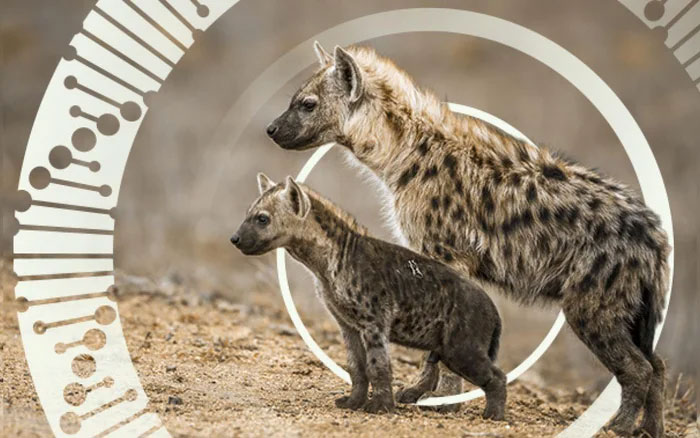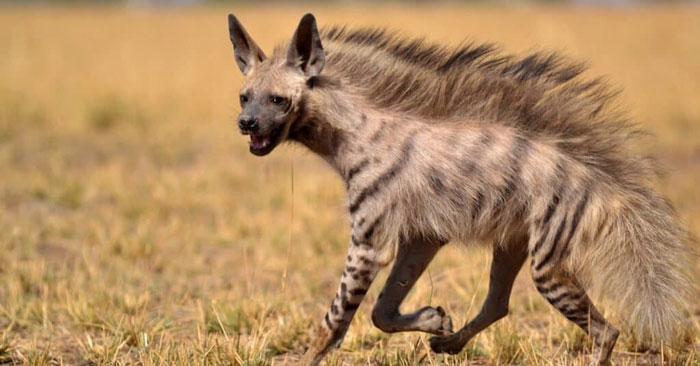Did you know: Are hyenas dogs or cats?
There is much confusion about the origins of hyenas and their nature. The strange physiology of hyenas has made them a source of research for zoologists around the world.
What exactly is a hyena? Is a hyena a member of the canine family? Or is it a member of the cat family, or a family of animals altogether? The answer to that question is a bit complicated. The hyena can be described as an animal with a 'dog-like' body and 'cat-like' anatomy , but it is truly a unique creature in its own right.

Hyenas are a distinct family within the order Carnivora.
However, misconceptions about this animal still abound. They are not wild dogs, and they are certainly not simple scavengers.
Let's start with the basics: hyenas are a distinct family within the order Carnivora. This family contains four living species. The spotted hyena, brown hyena , and aardwolf are all native to sub-Saharan Africa. The striped hyena is endemic to North Africa, the Middle East, and the Indian subcontinent.
Neither of them are threatened with extinction, exactly, but striped and brown hyenas are both threatened by habitat loss and illegal hunting. And we know from the fossil record that many of these species have gone extinct in the past, dating back millions of years.
All four species share a number of characteristics, but the spotted hyena is perhaps the strangest . It has undergone some significant changes over the past few million years that distinguish it from other closely related animals.

Striped hyenas are nocturnal animals but can be seen coming out of their dens around dusk and dawn.
Are hyenas dogs or cats?
Technically, hyenas are not true felines like tigers, leopards, and house cats, all of which are members of the Felidae family . Instead, hyenas belong to a separate group that is more closely related to the feline branch than to the canine family.
The order Carnivora, to which hyenas belong, first appeared around 50 to 60 million years ago. These early carnivores developed specialized teeth for tearing flesh. Based on at least partial reconstructions of the fossil record, paleontologists know that some of them may have resembled modern weasels and were adapted to climbing trees.
The first carnivores split very quickly into separate dog and cat lineages. Both branches went their separate ways, giving rise to new forms. Then, about 30 million years ago, the cat lineage split again into two major groups. One branch gave rise to the modern cat family. The other branch gave rise to hyenas, mongooses, and vipers (like the Asian palm civet).

Changing environmental conditions over the past 10 million years favored the evolution of larger hyenas.
Around 10 to 20 million years ago, the true hyena lineage began to take shape as a unique and distinct group. It branched off into at least three separate families, only one of which (the true hyenas) is apparently still alive today. Changing environmental conditions over the past 10 million years eventually began to favor the evolution of larger, more robust hyenas.
Although they last shared a common ancestor about 30 million years ago, cats, hyenas, mongooses, and vipers all belong to a single order that taxonomists now call Feliformia .
Feliformia comes from a Latin term meaning an animal that resembles a cat in shape or appearance, which is simply a description of their evolutionary relationship. It is not a description of what they are. And in fact, hyenas are no longer typical of modern cats.
How are hyenas like cats?
The evolutionary relationship between hyenas and cats may not be obvious at first because they look so different. But there are actually a few characteristics that they share. One defining characteristic shared by nearly all members of Feliformia (cat-like carnivores) is the unique bone structure of the middle and inner ears . It's a very small detail, but its presence in nearly all Feliformia species suggests that it may have evolved very early in the lineage and was then passed down to all descendant species.
Another similarity between hyenas and cats is their very rough tongues, which consist of similar barbs or bristles to help tear flesh from their prey and also to help groom their fur. You may be interested to learn that hyenas groom themselves with their tongues in a similar way to cats.
However, aside from a few other obvious similarities, hyenas and cats are very different animals. After all, it has been 30 million years since they last shared a common ancestor. That's more than enough time for hyenas to evolve into something very different. Thirty million years is more than the amount of time that separates humans from most apes and monkeys, for example. So, despite being members of the Feliformia order, hyenas really aren't anything like cats.

Hyenas and cats have unique bone structures of the middle and inner ears.
How are hyenas different from cats?
Hyenas are actually different from cats in many ways. One of the most important differences is the pack nature of their hunting strategy. While some species prefer to scavenge for leftovers, hyenas are also talented hunters. Unlike cats, they typically cannot climb trees or ambush their prey, instead preferring to chase their prey on the ground and tear them apart with their teeth rather than their claws. These teeth actually bear a strong resemblance to those of dogs . This is probably because teeth are very useful tools for the hyenas' pack hunting strategy.
The hunting strategy also reflects the species' social structure. The basis of hyena society is the clan, which can consist of 80 members and sometimes more. Although hyenas work together to bring down prey, life in the pack is not entirely cooperative. Hyenas form strict dominance hierarchies that determine access to both food and mates.
Striped hyenas, brown hyenas, and aardwolves have all adapted to societies that are typically led by males. Spotted hyenas, on the other hand, are the complete opposite: their social structure is built around a matriarchal organization, with a single female representing the core of the clan. She will have priority access to food and mates over other females.

The hunting strategy also reflects the social structure of this species.
In short, we can say that hyenas are more closely related to cats than dogs . However, this relationship is quite distant. The last time they shared a common ancestor with cats was about 30 million years ago. This has given hyenas plenty of time to develop their own unique characteristics.
- Hyenas and crocodiles in turn unleashed a sudden killing of wild dogs
- Stealing food, hyenas are hunted by a pack of wild dogs
- Dogs or cats love humans more? There have been official conclusions from science!
- 9 million years ago, bear dogs and cats used to live together
- Video: An interesting combination of cats and dogs
- Why do dogs hate cats?
- Researching neuronal cells: dogs 'twice as smart' cats
- New breed of hybrid cat wolf
- Headaches, epilepsy because of parasitic roundworm in cats and dogs
- Smart people often talk to dogs and cats?
- The rules to remember before you want to breed cats and dogs
- 'It is difficult for cats to come to the house, dogs come to the house', why?
 Animal 'suffering' after hibernation
Animal 'suffering' after hibernation Why do goats climb well?
Why do goats climb well? Scientists were surprised to see chimpanzees eating turtles
Scientists were surprised to see chimpanzees eating turtles Giant catfish died deadly due to drought in Thailand
Giant catfish died deadly due to drought in Thailand